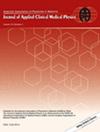Quantification and dosimetric impact of intra-fractional bladder changes during CBCT-guided online adaptive radiotherapy for pelvic cancer treatments
Abstract
Purpose
This study quantitatively evaluates bladder changes and their dosimetric impact during the on-couch adaptive process on a commercial CBCT-based online adaptive radiotherapy (CT-gART) platform.
Methods
Data from 183 fractions of ten patients receiving online ART for pelvic cancers were analyzed retrospectively. Bladder contours were automatically generated and revised by an expert for each pair of planning and verification CBCTs. Bladder shape changes were assessed using geometric and boundary distance metrics. A deformable image registration (DIR) workflow was implemented to obtain spatial motion characteristics, validated by the dice similarity coefficient between bladder contours. Dosimetric parameters were quantified by warping ’intended’ dose distributions to the verification CBCT anatomy using DIR to evaluate coverage and OAR objectives.
Results
Bladder volume changed noticeably during the on-couch adaptation process (19.7 ± 3.3 min). Day-to-day bladder expansion showed an average increase of 3.4 cc/min ± 1.5 cc/min for the full bladder and 0.8 cc/min ± 0.3 cc/min for empty bladder protocols. Deformation occurred mainly in the superior region and was more pronounced for the full bladder protocol. Displacements over 5 mm in cranial-caudal and anterior-posterior directions averaged 16% and 5% of the volume for full bladders and 5% and 4% for empty bladders, respectively. CTV coverage (V100%) was maintained when the bladder was the target, but PTV V95% was reduced by an average of 7%. For non-bladder treatments, bladder constraints increased slightly for supine subjects (0.5 Gy/fx), with prone subjects almost unaffected.
Conclusions
A framework using auto-segmentation and DIR was developed to evaluate the intra-fractional motion of the bladder during CTgART. Results suggest that reducing the isotropic PTV margin to less than 7 mm may be feasible for oART, allowing patient-specific anisotropic margins while maintaining the quality of the adaptive plan.

 求助内容:
求助内容: 应助结果提醒方式:
应助结果提醒方式:


